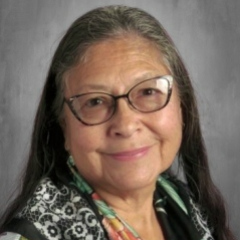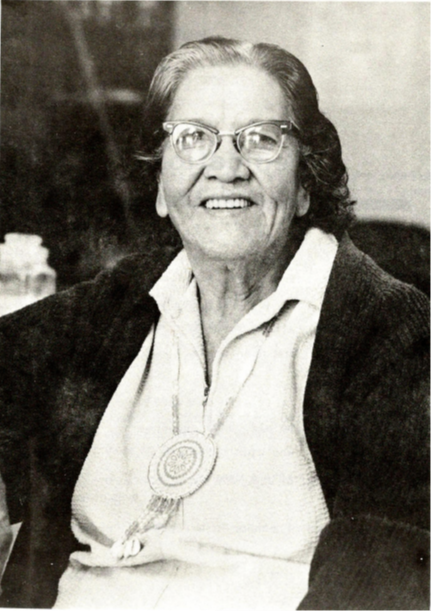Director, Umóⁿhoⁿ Language & Cultural Center (ULCC)
In Recognition of the Children of Charles and Elizabeth Stabler
Adopted Grandson and Documenter Dr. Mark Awakuni-Swetland
Original foreword by Mark Swetland (1977)
I hadn’t realized that this “little” project was going to take me six years. If I had, I would have thought twice about it. As it is, we are far from finished. There are innumerable additions to be made.
To start at the beginning... In September of 1971 I was asked to accompany my elder brother to the opening night of language classes being offered at the Lincoln Indian Center. Although he never attended that class, I did. There were twenty or more students. Half Indian and Half non-Indian. The teacher was a lady by the name of Elizabeth Stabler.
Mrs. Stabler was using an old book for her reference guide. It was the Twenty-seventh Annual Report of the Bureau of American Ethnology, written by Alice C. Fletcher and Francis La Flesche, 1905. This book contained subject lists of Omaha words which we used in the class. I found a copy of the newer reprinted edition published by the University of Nebraska Press. Once I caught on to the phonetic system. I volunteered to help Elizabeth write words for the classes.
Unfortunately, the class enrollment dwindled. By late fall the average number of students was two of three. Since I was making some progress we decided to continue working. Sometime during that first winter, we somehow hatched the idea of putting together a dictionary. We thought it might be helpful, since only a few words were written in the La Flesche book. From then on, I would start compiling lists of words for Elizabeth to translate.
As time passed, I became more attracted towards the Indian community in Lincoln. I became acquainted with the Stabler family, as well as their relatives. Through the assistance of Mr. Clyde Sheridan, Jr. and the sponsorship of Charles Stabler, I was initiated into the Omaha Tia-Piah Society. In the fall of 1974, Mr. Raymond Phillips accepted the task of pinning the eagle feather for me. At that time I asked Charles Stabler if he would give me an Omaha name. He said that he would consider it.
After conferring with the elder people and the Tribal Council, Charles confirmed that I could be given an Omaha name. I asked that he would be one to pick it out for me. Being a member of the Iⁿkésabe (Buffalo) clan, he chose from their names. After some discussion, we decided in one. In January of 1977 I put up a gourd dance and dinner to honour that occasion. At this time the name was announced as is tradition. By the name given me... Úthixide... I took Charles and Elizabeth as my grandparents.
All during this time, Elizabeth and I have been working on the dictionary, or “The Book” as it came to be known as. The writing system follows that of La Flesche. I thought it would be better this way so that what little has been published the system, but they have been unable to find a usable replacement.
In compiling my lists of words I used three English, one Navajo, two Choctaw, and three Sioux dictionaries. From the list each word was written on an index card and alphabetized. Any special translations were noted. This summer I typed up the rough-draft from these stacks of cards. Corrections were then made by Elizabeth... with assistance of Charles, of course.
Then I had to retype the whole thing again for the printer.
Elizabeth and I had been wondering about how to pay the costs for printing this thing. There was no way either of us could afford it. Some friend suggested applying for a grant to help in material costs. Being unsure of myself, Ron Waggoner of Concordia Teacher’s College in Seward, Nebraska did the initial investigating. He put me in contact with the Center for Applied Linguistics. After explaining our situation, they agreed to award a grant. That is how this First Edition-First printing came to be.
So at last ---
I’m not a linguist. Seeing the complexity of this project, I don’t think I ever wish to be one. I am hoping that this material gets introduced into the school systems. Politics being what they are, it will probably take time. That will be alright because I hope the older people will read this in the meantime and inform me of corrections. I, myself, have not been able to learn the Omaha language like I should have. I think this is partly due to my always concentrating on writing the word down. With the book done, I hope to work more on my personal vocabulary.
If you expect to learn the Omaha language from this book alone, forget it. This is only a guide. This will not replace the fathers, mothers, and grandparents. They are the teachers. Go to them...
- Úthixide, 1977

Mark Swetland, Elicitor and Transcriber
Contributors to Umóⁿhoⁿ Iye of Elizabeth Stabler
Introduction
Eyóⁿ moⁿniⁿ-a? Thatʰí-tʰe údoⁿ! We are very pleased to share with you the first online edition of Umóⁿhoⁿ Íye of Elizabeth Stabler. Our intent is to make the words of Elizabeth Stabler and the efforts of documenter, Mark Swetland, available to all Umóⁿhoⁿ people.
Elizabeth Stabler, was a beloved Umóⁿhoⁿ Elder woman and a fluent Umóⁿhoⁿ Íye speaker, and Mark Swetland was a young and enthusiastic learner. Through their long term relationship, and shared love of Umóⁿhoⁿ language, they worked together , and compiled a list of more than 3,500 words. In essence, Mark never quit documenting language and culture with the assistance of his relationship to other Umóⁿhoⁿ people. Mark had established relationships within the Omaha, Lincoln and Macy communities over the course of his lifetime. He was adopted by the Stabler family of Lincoln and that relationship was the foundation of the expanded relationships to many families reservation wide.
Elizabeth and Mark were not familiar to writing Umóⁿhoⁿ Iye, but Mark understood a standard writing system should be used. In the beginning, Mark Swetland was a High School student when he started learning the Umóⁿhoⁿ Íye. At this time, he was also establishing the relationship to the Saunsoci/Stabler families.
In this new edition, from Umóⁿhoⁿ Íye to English, the team of Umóⁿhoⁿ Tribal Members Vida Stabler, Pat Phillips and Linguist Julie Marsault have checked spelling and completed the definitions. Others to acknowlegde are Tribal Members Emmaline Sanchez thiⁿge and Arlene Walker, and linguist Rory Larson. Together, they checked the pronunciation of the original words, and added explanations to some definitions. When Linguist Julie Marsault started to edit the dictionary, their work was of invaluable help to her.
Elizabeth Stabler's words are presented here with the spelling used at the Umóⁿhoⁿ Language & Cultural Center (UNPS), and in other institutions.
This is a work in progress. We are still adding words from the the original and reviewing those words. As of December 2023, about 300 words from the original version still need to be added.
Other contributing Elders who were contacted and discussed several words are: Octa Mitchell Keen, Alvina Webster, Arlington Saunsoci, Andre Saunsoci, Dwight Robinson, Laramie Wolfe, Valerie Wolfe.
We would also like to acknowledge the documentation efforts of Elders that worked at the Umóⁿhoⁿ Language and Cultural Center at UNPS from 1998 through 2023. This work is possible because the Elders entrusted their knowledge of the language to Tribal Members Vida Stabler and later Pat Phillips, who joined the ULCC in 2013. The sharing of Umóⁿhoⁿ culture and language is passed in an intimate way through relationships and shared history from the Elders to younger relatives.
Our intent is for the dictionary to be accessible to the people within their homes, work places, schools and cultural gatherings whenever an Umóⁿhoⁿ word is needed. The times and technology have now allowed the incredible work done by Elizabeth Saunsoci Stabler and Mark Awakuni-Swetland to be shared with all.

Vida Stabler
Hiⁿxpéwiⁿ

Julie Marsault, PhD
Linguist for Umóⁿhoⁿ Iye of Elizabeth Stabler project

